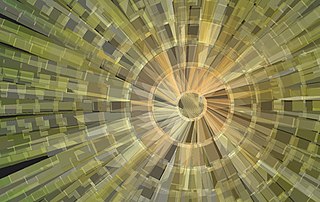Related Research Articles
Computer music is the application of computing technology in music composition, to help human composers create new music or to have computers independently create music, such as with algorithmic composition programs. It includes the theory and application of new and existing computer software technologies and basic aspects of music, such as sound synthesis, digital signal processing, sound design, sonic diffusion, acoustics, electrical engineering, and psychoacoustics. The field of computer music can trace its roots back to the origins of electronic music, and the first experiments and innovations with electronic instruments at the turn of the 20th century.

Generative art is that post-conceptual art that in whole or in part has been created with the use of an autonomous system. An autonomous system in this context is generally one that is non-human and can independently determine features of an artwork that would otherwise require decisions made directly by the artist. In some cases the human creator may claim that the generative system represents their own artistic idea, and in others that the system takes on the role of the creator.

Generative grammar is a theoretical approach in linguistics that regards grammar as a domain-specific system of rules that generates all and only the grammatical sentences of a given language. In light of poverty of the stimulus arguments, grammar is regarded as being partly innate, the innate portion of the system being referred to as universal grammar. The generative approach has focused on the study of syntax while addressing other aspects of language including semantics, morphology, phonology, and psycholinguistics.
Algorithmic composition is the technique of using algorithms to create music.

Karlheinz Essl is an Austrian composer, performer, sound artist, improviser, and composition teacher.
"Cognitive Constraints on Compositional Systems" is an essay by Fred Lerdahl that cites Pierre Boulez's Le Marteau sans maître (1955) as an example of "a huge gap between compositional system and cognized result," though he "could have illustrated just as well with works by Milton Babbitt, Elliott Carter, Luigi Nono, Karlheinz Stockhausen, or Iannis Xenakis". To explain this gap, and in hopes of bridging it, Lerdahl proposes the concept of a musical grammar, "a limited set of rules that can generate indefinitely large sets of musical events and/or their structural descriptions". He divides this further into compositional grammar and listening grammar, the latter being one "more or less unconsciously employed by auditors, that generates mental representations of the music". He divides the former into natural and artificial compositional grammars. While the two have historically been fruitfully mixed, a natural grammar arises spontaneously in a culture while an artificial one is a conscious invention of an individual or group in a culture; the gap can arise only between listening grammar and artificial grammars. To begin to understand the listening grammar, Lerdahl and Ray Jackendoff created a theory of musical cognition, A Generative Theory of Tonal Music. That theory is outlined in the essay.

Another Day on Earth is the twenty-second solo studio album by Brian Eno, released on 13 June 2005 in the UK and Europe through Hannibal Records, and on 14 June 2005 in the US. The album predominantly recorded and mixed on Macintosh software, using Logic Pro, over a period of four years.

In computing, procedural generation is a method of creating data algorithmically as opposed to manually, typically through a combination of human-generated content and algorithms coupled with computer-generated randomness and processing power. In computer graphics, it is commonly used to create textures and 3D models. In video games, it is used to automatically create large amounts of content in a game. Depending on the implementation, advantages of procedural generation can include smaller file sizes, larger amounts of content, and randomness for less predictable gameplay. Procedural generation is a branch of media synthesis.
It's Gonna Rain is a tape composition written by Steve Reich in 1965. It lasts about 18 minutes. It was Reich's first major work and is considered a landmark in minimalism and process music.

Algorithmic art or algorithm art is art, mostly visual art, in which the design is generated by an algorithm. Algorithmic artists are sometimes called algorists.

Tao Group was a software company with headquarters in Reading, Berkshire, UK. It developed the Intent software platform, which enabled content portability by delivering services in a platform-independent format called Virtual Processor (VP). The business's IP portfolio was sold in May 2007 to Cross Atlantic Capital Partners.

A Year with Swollen Appendices is a book by Brian Eno. The paperback book was published by Faber and Faber in 1996 and is divided into two sections. The first part is a diary covering the year 1995, the second part, the 'swollen appendices' of the title is a collection of essays, short stories and correspondence. It was re-released with a new introduction by the author in 2021.

January 07003 is the twenty-first solo studio album by Brian Eno, released in 2003.

"Lightness" is the sixteenth solo studio album by Brian Eno, released in 1997, and re-released in 2000 by Opal Music. The music on the album was made for an Installation—a show featuring music and visuals—that took place at the Marble Palace in Saint Petersburg, which accommodates permanent exhibitions of the State Russian Museum, from November to mid-December 1997.
Koan is a generative music engine created by SSEYO, a company founded by Pete Cole and Tim Cole. The Koan technology is now owned by Intermorphic Limited, co-founded by the Cole brothers in 2007.

Brian Peter George Eno, also mononymously known as Eno, is an English musician, songwriter, record producer and visual artist. He is best known for his pioneering contributions to ambient music and electronica, and for producing, recording, and writing works in rock and pop music. A self-described "non-musician", Eno has helped introduce unconventional concepts and approaches to contemporary music. He has been described as one of popular music's most influential and innovative figures. In 2019, he was inducted into the Rock and Roll Hall of Fame as a member of Roxy Music.

viral symphOny is a collaborative electronic noise music symphony created by the postconceptual artist Joseph Nechvatal. It was created between the years 2006 and 2008 using custom artificial life C++ software based on the viral phenomenon model. It is 1 hour and 40 minutes in length. The first movement of viral symphOny - and raw viral field material - was released in 2006 as a CD by The Institute for Electronic Arts in Alfred, New York. A low resolution extract from the pOstmOrtem section of viral symphOny was published in NME magazine.
The generative theory of tonal music (GTTM) is a system of music analysis developed by music theorist Fred Lerdahl and linguist Ray Jackendoff. First presented in their 1983 book of the same title, it constitutes a "formal description of the musical intuitions of a listener who is experienced in a musical idiom" with the aim of illuminating the unique human capacity for musical understanding.

Reflection is the twenty-eighth studio album by Brian Eno, released on 1 January 2017 on Warp Records. It is a piece of generative ambient music produced by Eno, which plays indefinitely via an app, modulating its output at different times of the day. A pre-recorded version of the album is available on CD and vinyl, which runs for 54 minutes. Digital streaming versions of the album update on a seasonal basis. It was nominated for the 2017 Grammy Award for Best New Age Album and was released to a positive acclaim by critics.
Timothy Didymus is a British artist and musician based in Brighton. He is considered a pioneer in the field of generative music. Didymus has collaborated with artists such as Brian Eno, Cornelia Sollfrank, Emilia Telese and presented at institutions and festivals such as ZKM, Ars Electronica, International Symposium on Electronic Art (ISEA), Werkleitz Biennale of Multimedia Arts, Liverpool Biennial, De La Warr Pavilion, Fort Process.
References
- Artística de Valencia, After The Net, 5 – 29 June 2008, Valencia, Spain: catalogue: Observatori 2008: After The Future, p. 80
- Biles, A. 2002a. GenJam in Transition: from Genetic Jammer to Generative Jammer. In International Conference on Generative Art, Milan, Italy.
- Chomsky, N. 1956. Three models for the description of language. IRE Transcripts on Information Theory, 2: 113-124.
- Collins, N. 2008. The analysis of generative music programs. Organised Sound, 13(3): 237–248.
- Cope, D. 1991. Computers and musical style. Madison, Wis.: A-R Editions.
- Dorin, A. 2001. Generative processes and the electronic arts. Organised Sound, 6 (1): 47-53.
- Eno, B. 1996. Generative Music. http://www.inmotionmagazine.com/eno1.html (accessed 26 February 2009).
- Essl, K. 2002. Generative Music. http://www.essl.at/bibliogr/generative-music.html (accessed 22 Mar 2010).
- García, A. et al. 2010. Music Composition Based on Linguistic Approach. 9th Mexican International Conference on Artificial Intelligence, MICAI 2010, Pachuca, Mexico. pp. 117–128.
- Intermorphic Limited History of Noatikl, Koan and SSEYO (accessed 26 February 2009).
- Lerdahl, F. and R. Jackendoff. 1982. A generative theory of tonal music. Cambridge, Mass: MIT Press.
- Lippe, C. 1997. Music for piano and computer: A description. Information Processing Society of Japa SIG Notes, 97 (122): 33-38.
- Loy, G. and C. Abbott. 1985. Programming languages for computer music synthesis, performance and composition. ACM Computing Surveys, 17 (2): 235-265.
- Nierhaus, G. Algorithmic Composition - Paradigms of Automated Music Generation. Springer 2009.
- Rowe, R. 1991. Machine Learning and Composing: Making Sense of Music with Cooperating Real-Time Agents. Thesis from Media Lab. Mass.: MIT.
- Winkler, T. 1998. Composing Interactive Music. Cambridge, Massachusetts: MIT Press.
- Wooller, R., Brown, A. R, et al. A framework for comparing algorithmic music systems. In: Symposium on Generative Arts Practice (GAP). 2005. University of Technology Sydney.